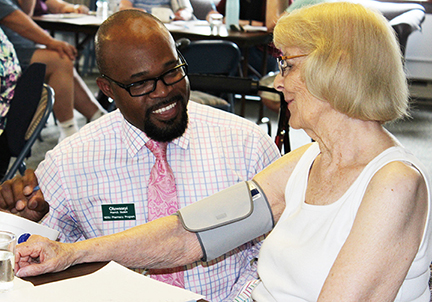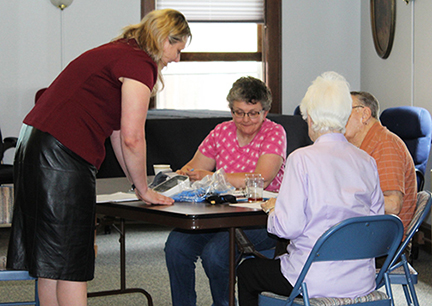
June 16, 2017 – Fargo, North Dakota – Every 40 seconds, someone suffers a stroke. Knowing the signs of a stroke and how you can lessen risk factors are important. Students from the North Dakota State University School of Pharmacy and Dr. Marketa Marvanova are sharing information and tips on risk factors for stroke and additional education in the community.
The outreach is part of “Pharmacist-Led Stroke/TIA Risk Identification, Prevention and Care-Seeking Study in Fargo, North Dakota,” a research project of Dr. Marvanova, who is chair of Pharmacy Practice at NDSU. The research was piloted with seed funding from the College of Health Professions.
The goal of the program is to improve knowledge about stroke prevention, help people know the signs of stroke, and identify those who may need additional clinical care to decrease risk for stroke or a transient ischemic attack, commonly called a mini-stroke.
More than 95 people have participated in the program over the course of four months. Marvanova partnered with care committees and parish nurses at Olivet Lutheran Church, First Lutheran Church, Pontoppidan Church and First United Methodist Church in Fargo to deliver the stroke awareness and education program.
NDSU pharmacy students participating in the community outreach took blood pressures and heart rates and helped those participating learn about risk factors, stroke prevention and signs of a stroke.
Second-year pharmacy student Julius Kunweleyil from Ghana, West Africa was one of the students assisting in the outreach program. He currently works in the emergency room at Sanford Health.
“I hope that I would be able to learn more on how to organize some of these health education programs so that sometime in my future career, I can replicate the process for other diseases and conditions to help bring change in the communities in which I will practice,” said Kunweleyil.
Other students made additional discoveries during the program. “One thing I found interesting is the different education levels of stroke that members of the community have,” said Michelle Bjerke, a second-year pharmacy student from Fosston, Minnesota. “Some have a great understanding of the importance of stroke prevention and the signs and symptoms of a stroke, while others had a limited understanding of stroke.”
Bjerke hopes to learn more about patient outreach within the community and how a pharmacist can assist in important medical screenings.

Third-year pharmacy student Sam Dwyer from Bemidji, Minnesota, hopes the experience will help him refine his ability to interact with patients. “I thought it was interesting at how appreciative the community was to having college students performing a health screening for them. They were encouraged by our presence and I was asked if I would ever be back again,” he said.
What students learn in community outreach events augments their classroom experience. For second-year pharmacy student Ariana Vidger of Fargo, the activity directly relates to her training.
“One of my classes heavily covers cardiovascular risk factors and the prevention and treatment of diseases such as stroke and TIA. It is really interesting to see these theoretical concepts being used to actually identify patients who need additional attention,” said Vidger.
“A lot of pharmacy school is very focused on knowledge of drugs and analyzing patient cases on paper. It can sometimes feel disconnected from the final goal of helping improve people's health. This is a good opportunity to practice what is being taught, while hopefully providing benefit to patients,” she said.
Other students participating in the community outreach activity included Zach Storey, Kortney Schroeder, Oluwaseyi Ogundolani, and Ashley Freeman.
For parish nurses such as Katie Kringstad of First Lutheran Church, it’s an opportunity to connect those she serves with health information. “A lot of people don’t know the risks of having a stroke, and I think it’s a fear for a lot of people,” she said.
“If they do have high blood pressure or other things, then it could be caught to follow up with it. It could be life saving,” said Kringstad, who also has served as a preceptor to help provide clinical experience for NDSU nursing students.
Linda Bates from the care team at First United Methodist Church said the program was well received. “Your mission and passion for spreading the word on how we can control many parts of our health is one we need to hear. I think you could tell that the audience was very receptive to your message,” said Bates.
The community-based pilot research project by Marvanova and NDSU pharmacy students was a first step toward health education on the important topic of stroke risk factors and prevention. If funding is available in the future, Marvanova hopes to offer the program to communities in rural areas as well.
For information on the signs of stroke and stroke prevention, visit https://www.cdc.gov/stroke/about.htm
As a student-focused, land-grant, research university, we serve our citizens.


